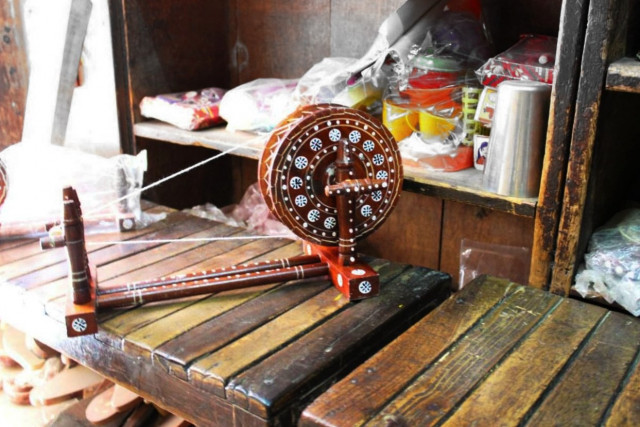
"The art of transforming wooden pieces into toys runs in my family for generations," says craftsman Muhammad Sarfaraz who is associated with the business for the past 15 years. The family lives in Raja Jung village near Raiwind and makes toys that portray the province's culture. "We make toys such as charghay, lattu, and madhani which children enjoy playing with."
Maheen, a young girl who had accompanied her father to the workshop to buy toys, told Express News that she preferred wooden toys over plastic ones. "Toys that are made out of plastic break easily and end up in the trash," she explains.
Explaining the process of crafting toys, Sarfraz says that eucalyptus wood is dried and later cut down to the desired size to make toys and decoration pieces. Then, the wood is moulded into various shapes on a lathe machine and is painted. "We usually make toys that are reflective of the culture and tradition of Punjab."
Sarfaraz maintains that people should purchase wooden toys as plastic toys are fragile and also contribute to greenhouse gas emissions and many other environmental issues. "People in both urban and rural areas prefer wooden toys because they are cheap and long lasting," he said, adding that these toys are usually sent to Lahore, Multan, Rawalpindi, Chiniot, Karachi and other big cities to sell them. The toys can also be easily bought from shops near shrines, he said.
Wooden toys are usually used as decorative pieces for homes. An elderly craftsman, Haji Sadiq, says that the return for the items is comparatively low considering the effort and energy invested to make them. "A chargha is sold at Rs300 while a craftsman can barely make 3 or 4 charghas a day," he says. Haji has been working in the business for the past 40 years and has trained numerous students.
However, his children are now seeking other employment due to the fact that it isn't a lucrative business.
"It is disheartening to see the art slowly fading away," he expresses.


















COMMENTS
Comments are moderated and generally will be posted if they are on-topic and not abusive.
For more information, please see our Comments FAQ